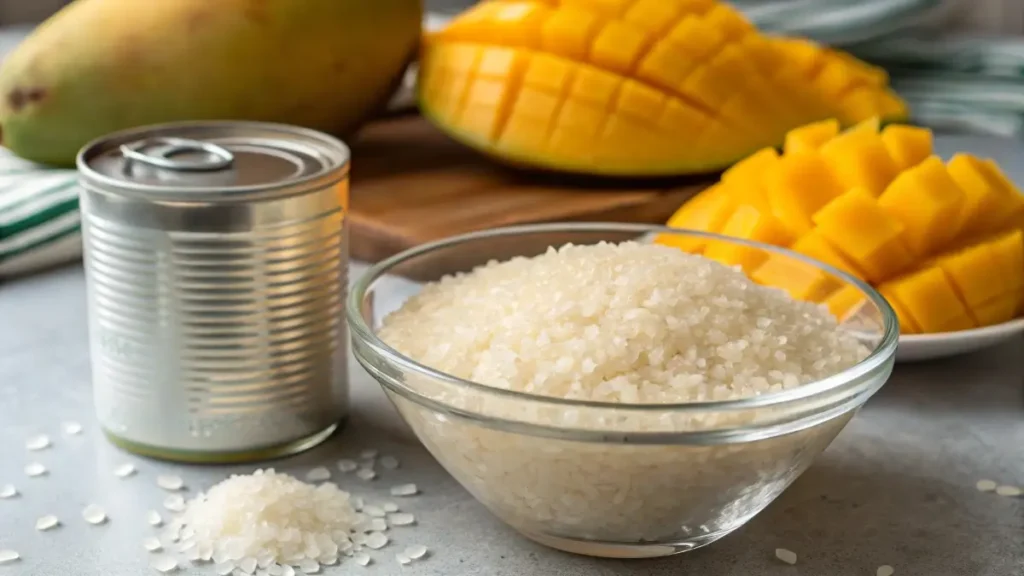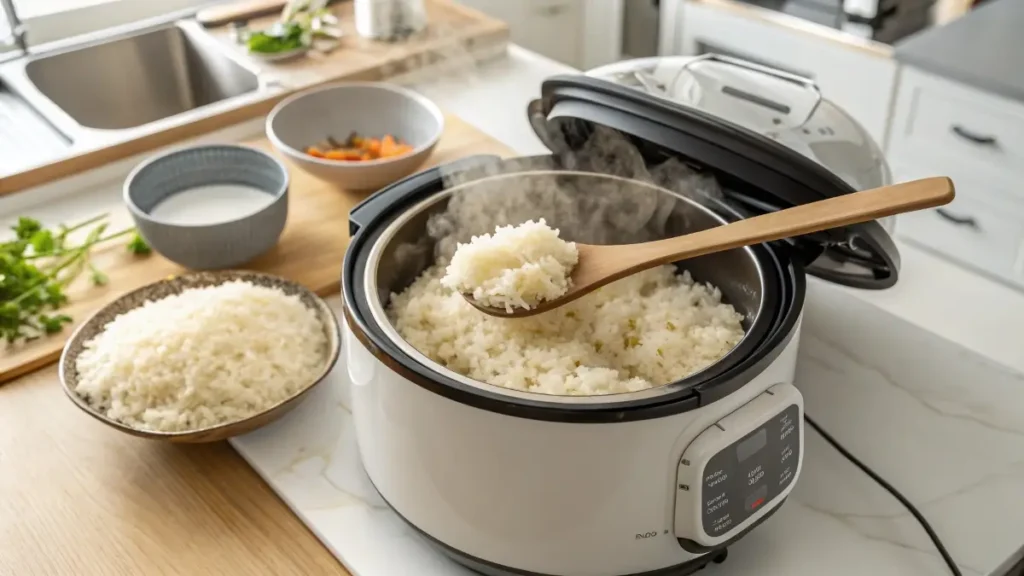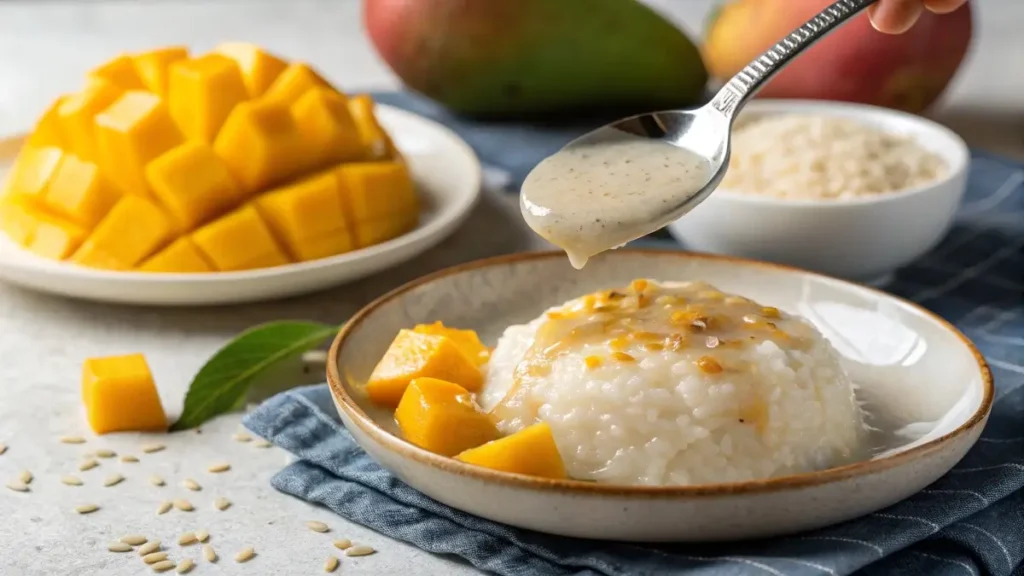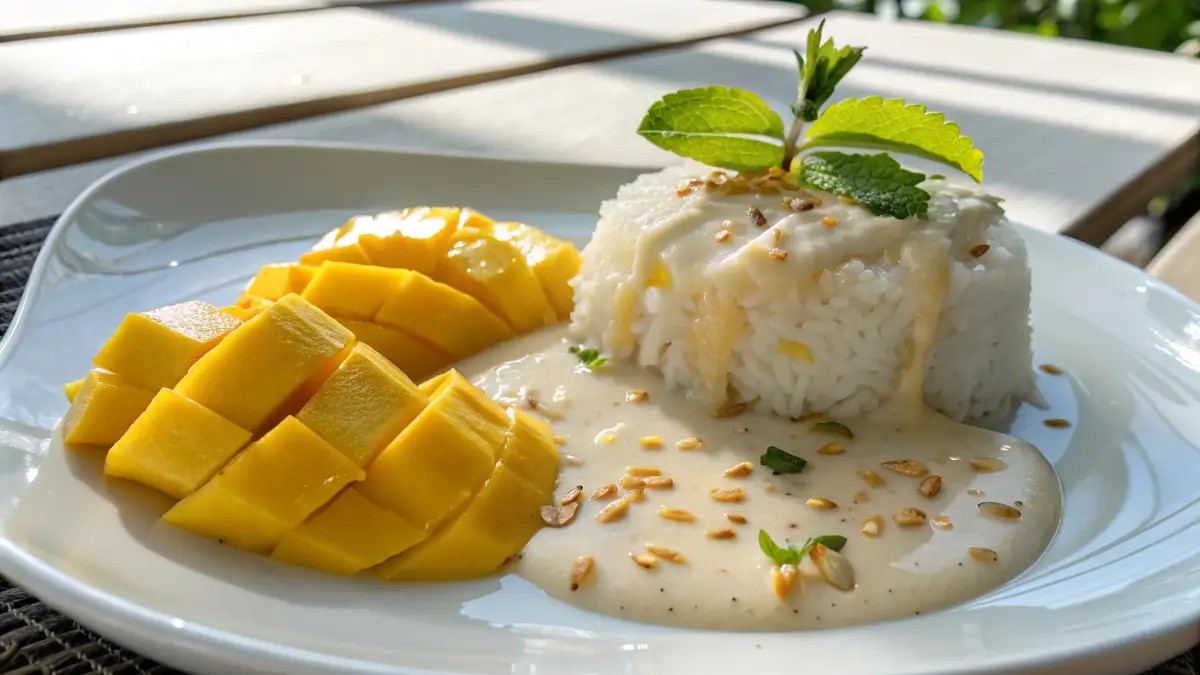How to Make Mango Sticky Rice in Rice Cooker
Mango sticky rice in rice cooker is one of Thailand’s most loved desserts. The mix of sweet, creamy coconut sticky rice and ripe mango creates a flavor that’s both simple and irresistible. Traditionally, this dish is steamed, but not everyone has a steamer. The good news? You can make mango sticky rice in a rice cooker, and the results are just as delicious.
This article walks you through every step—from choosing the right rice to perfecting the coconut sauce. You’ll learn why glutinous rice matters, how to get the water ratio right, and what mistakes to avoid. Whether you’re cooking for yourself or impressing guests, this easy method simplifies the process without cutting flavor.
Discover great ideas like this one in our full guide to delicious Asian desserts.
Table of Contents
Introduction to Mango Sticky Rice
The Origins of Mango Sticky Rice
Mango sticky rice, or khao neow mamuang, is a traditional Thai dessert with roots in Southeast Asia. It combines sticky rice, sweetened coconut milk, and ripe yellow mangoes. Often served during mango season (March to June), this dish reflects the balance of flavors found in Thai cooking—rich, sweet, and fragrant.
While it’s commonly enjoyed in Thailand, Laos, Cambodia, and parts of Malaysia, it has gained worldwide popularity thanks to its unique texture and vibrant look. Traditional recipes use bamboo steamers and muslin cloths, but this version caters to the modern kitchen with just a simple rice cooker.
Why Use a Rice Cooker for Sticky Rice?
Using a rice cooker simplifies everything. It removes the guesswork from cooking sticky rice on the stovetop or in a steamer. With precise heat and automatic shut-off features, a rice cooker delivers consistent results.
This method is ideal for home cooks who don’t own traditional equipment. It’s faster, cleaner, and just as effective. Plus, rice cookers are often multi-functional, so you can use them to prep other parts of the dish, like heating the coconut sauce.
Looking for inspiration? Try our guide on cilantro lime rice in a rice cooker.
Ingredients and Equipment You’ll Need
Best Type of Rice for Mango Sticky Rice
The heart of this dessert is the rice. For authentic results, use Thai glutinous rice, often labeled as sticky rice or sweet rice. This variety becomes soft, sticky, and chewy when cooked—exactly the texture mango sticky rice needs. Avoid long-grain or standard white rice, which won’t deliver the same results.
If you can’t find Thai glutinous rice, look for short-grain glutinous rice at Asian grocery stores or online. Do not confuse sticky rice with sushi rice or jasmine rice. Jasmine rice may work in a pinch, but it will lack the chewiness and sticky hold you need for this dessert.
Check out our guide to rice-based desserts like rice krispie ice cream for more sweet ideas using rice.
Coconut Milk, Mangoes, and Sweetener Essentials
Once your rice is sorted, focus on the rich coconut sauce. You’ll need:
- Full-fat canned coconut milk: Avoid light versions. Full-fat gives the thick, creamy texture required for both the sauce and soaking.
- Sugar: White granulated sugar works best, but palm sugar or coconut sugar can be used for a deeper flavor.
- Salt: Just a pinch balances out the sweetness of the coconut milk.
For the fruit, use ripe yellow mangoes, preferably Ataulfo or Nam Dok Mai varieties. These types are naturally sweet and non-fibrous, making them perfect for pairing with sticky rice. Look for mangoes that give slightly when pressed and have a strong mango aroma near the stem.
Don’t miss our frozen drinks guide to find refreshing pairings with your mango sticky rice dessert.

Equipment Checklist for This Recipe
Here’s what you need to get started:
| Equipment | Purpose |
|---|---|
| Rice Cooker | To cook glutinous rice evenly |
| Mixing Bowl | To soak and rinse rice |
| Small Saucepan | For heating and thickening coconut mix |
| Rubber Spatula | For folding coconut sauce into rice |
| Sharp Knife | To cleanly slice mangoes |
| Measuring Cups | Accuracy matters in this dessert |
No fancy tools or steaming baskets required. Just a reliable rice cooker and a few kitchen basics.
Learn more about easy rice dishes that you can whip up with the same equipment.
Prepping Sticky Rice for the Rice Cooker
Washing and Soaking the Rice Properly
Preparing glutinous rice the right way is key to achieving its signature sticky texture. It starts with thorough washing. Place your rice in a large bowl and rinse it under cold water. Swirl the grains gently with your fingers, then drain. Repeat this process 3 to 5 times, or until the water runs mostly clear. This step removes excess starch, preventing the rice from becoming too gummy.
After rinsing, soak the rice in water for at least 4 hours, or overnight if you can. Soaking softens the grains and ensures even cooking inside the rice cooker. This step is not optional. If you skip it, your rice may turn out hard in the center or cook unevenly.
Tips for Soaking Time and Texture
The ideal soaking time is 4 to 6 hours. If you’re short on time, a minimum of 2 hours can work in a pinch, though the texture won’t be as soft and sticky. Avoid soaking longer than 12 hours, as it can lead to overly mushy or broken grains.
For best results:
- Use room-temperature water when soaking.
- Drain the rice completely before adding it to your rice cooker.
- If your rice cooker doesn’t have a sticky rice setting, use the standard white rice mode.
Proper soaking ensures that the rice grains absorb moisture before cooking. That means fluffier, more cohesive rice once it’s done.
Discover other rice methods in our article on authentic Spanish rice—perfect for savory dishes when you’re not in the mood for dessert.
Cooking Sticky Rice in a Rice Cooker
Water-to-Rice Ratio for Sticky Rice
Getting the ratio right is crucial when cooking sticky rice in a rice cooker. Too much water, and your rice will turn mushy. Too little, and it will stay undercooked.
For glutinous rice, the best ratio after soaking is:
1 cup soaked sticky rice : 1 cup water
Remember, this ratio applies after the rice has been soaked and drained. So if you start with 1 cup of dry rice, it will absorb some water during soaking and still need 1 cup of water during cooking. This ensures the rice cooks evenly and sticks together just enough for the classic chewy texture.
If your rice cooker runs hot or tends to overcook, slightly reduce the water to ¾ cup per 1 cup of soaked rice to prevent over-softening.

Cooking Instructions and Timings (Step-by-Step)
Once your rice is rinsed, soaked, and drained, and your water measured, follow this simple process:
- Add the rice and water to the rice cooker. Use the correct ratio and close the lid.
- Select the “white rice” or “regular” setting. If your rice cooker has a “sticky rice” or “sweet rice” mode, use that instead.
- Let it cook completely. This usually takes 20–30 minutes, depending on your device.
- Once the rice cooker switches to “keep warm,” let the rice sit for 10 minutes. This resting time helps firm up the texture and allows residual steam to finish the cooking.
Avoid opening the lid too early or stirring the rice while it cooks. Patience ensures fluffy and cohesive sticky rice, ready to soak up the coconut sauce later.
Don’t miss our tips in this homemade energy drink recipe—a refreshing pairing after this indulgent dessert.
Making the Sweet Coconut Sauce
Ingredients for the Sauce
The coconut sauce is what brings this dish to life. It should be thick, creamy, and just sweet enough to balance the neutral sticky rice and fruity mango.
Here’s what you’ll need:
- 1 cup full-fat coconut milk
- ¼ cup granulated sugar
- ¼ teaspoon salt
- 1 teaspoon cornstarch (optional, for thickening)
- 2 tablespoons water (if using cornstarch)
Use only full-fat canned coconut milk, not the boxed or refrigerated kind. Those are often too watery and lack the creamy consistency this dessert requires.
How to Thicken and Sweeten the Sauce Perfectly
- In a small saucepan, combine the coconut milk, sugar, and salt over medium heat.
- Stir constantly until the sugar dissolves completely and the mixture starts to steam—do not boil.
- For a thicker sauce, mix the cornstarch and water in a small bowl, then stir it into the coconut mixture.
- Cook for another 2 to 3 minutes, stirring gently, until slightly thickened.
- Remove from heat and let cool slightly.
Aim for a smooth, pourable sauce that’s still rich and velvety. To thin it out, stir in a bit of coconut milk. If it’s too runny, simmer it longer or mix in extra cornstarch.
Looking for something equally rich and indulgent? Don’t miss our gluten-free fettuccine alfredo—a creamy main dish that pairs beautifully with this sweet Thai dessert.
Assembling Mango Sticky Rice
Slicing Mangoes the Right Way
Ripe mangoes are the shining star of this dessert, so how you slice them matters. Use mangoes that are soft to the touch but not mushy. The skin should be yellow and slightly wrinkled, which indicates full ripeness.
Follow these steps to slice them neatly:
- Stand the mango upright. The pit runs vertically through the center.
- Slice down each side of the pit to get two large “cheeks.”
- Use a paring knife to make lengthwise or crisscross cuts through the flesh without piercing the skin.
- Flip the cheek inside out and scoop or slice the flesh from the skin.
For added elegance, cut mangoes into thin slices or fan them out across the plate. This elevates presentation and makes the dessert feel restaurant-quality.
How to Plate and Pour Coconut Sauce
Now it’s time to bring everything together.
- Scoop a mound of warm sticky rice onto each plate. You can shape it with a small bowl for a neat dome look.
- Lay fresh mango slices beside or slightly over the rice.
- Spoon the warm coconut sauce generously over the rice. Add extra sauce on the side if you prefer it richer.
- Optional toppings: Toasted sesame seeds or mung beans add a nutty crunch. Some recipes even use a sprinkle of sea salt to enhance the sweetness.
The balance of warm rice, cold mango, and silky coconut sauce is what makes this dish unforgettable.

Don’t miss our ideas for other tropical favorites like pineapple upside-down cake to complement your sweet table.
Substitutions and Variations
Can You Use Jasmine Rice or White Rice Instead?
While Thai glutinous rice is the gold standard for mango sticky rice, you can use alternatives in a pinch—but expect differences in texture and flavor.
Jasmine rice has a mild fragrance and softer bite, but it won’t achieve the sticky, chewy texture needed to absorb the coconut sauce properly. You’ll end up with more of a coconut rice pudding than authentic mango sticky rice.
White long-grain rice is not recommended. It separates too easily, and the grains won’t hold the sauce. If you must substitute, opt for sushi rice—it’s stickier and better mimics glutinous rice when cooked properly.
When using substitutes:
- Add a little more water—up to 1¼ cups for every cup of rice—to ensure proper cooking and fluffiness.
- Expect less chew and more creaminess.
- Add a touch of vanilla or pandan extract to mimic traditional aroma.
Vegan, Sugar-Free, or Low-Fat Options
Mango sticky rice can be easily adjusted for dietary needs without losing its appeal.
Vegan Version
This dessert is naturally vegan if you use full-fat coconut milk and plant-based sweeteners.
Sugar-Free Option
Replace sugar with a natural sweetener like monk fruit, erythritol, or stevia. Be cautious with proportions—some sweeteners are more concentrated than sugar.
Low-Fat Version
Substitute full-fat coconut milk with light coconut milk. You’ll sacrifice some richness, but the dessert will be lighter and still tasty. You may need to thicken the sauce more using cornstarch or arrowroot.
For something totally different but equally comforting, learn how to make cottage cheese banana bread—a lighter dessert option for your menu rotation.
Storage and Reheating Tips
How to Store Leftover Sticky Rice and Mangoes
Mango sticky rice is best served fresh, but if you have leftovers, proper storage will help preserve texture and taste.
Sticky rice:
Transfer any leftover rice to an airtight container while it’s still warm. Let it cool completely before sealing. Refrigerate for up to 3 days.
Coconut sauce:
Store leftover sauce separately in a small container. It will thicken in the fridge, so reheat with a splash of coconut milk or water.
Mangoes:
Freshly sliced mango should be stored in a sealed container in the fridge and consumed within 24–48 hours. Mango tends to soften and release juice quickly, which may affect texture.
If you plan to store the whole dish assembled, keep components separate for best results.
Reheating Without Drying It Out
Reheating sticky rice can be tricky—it tends to dry out or harden. Here’s how to revive it properly:
Microwave method:
- Place rice in a microwave-safe bowl.
- Sprinkle 1–2 teaspoons of water or coconut milk over it.
- Place a damp paper towel over the dish and microwave for 30 to 45 seconds to reheat evenly and retain moisture.
Steamer method:
Wrap rice in foil or place in a heat-safe bowl inside a steamer. Steam for 5–8 minutes, checking for softness.
Sauce:
Reheat coconut sauce on the stovetop over low heat or microwave in 20-second intervals, stirring between bursts.
Avoid reheating mango slices. Serve them cold or at room temperature for best flavor and texture.
Want more ideas for using coconut milk? Explore our vegan yum yum sauce recipe for savory flavor pairings.
Common Mistakes to Avoid
Overcooked or Undercooked Rice
One of the most common pitfalls in making mango sticky rice is not getting the texture right. Glutinous rice should be tender, sticky, and slightly chewy—not mushy or crunchy.
Avoid these rice mistakes:
- Skipping the soak: Unsoaked rice will cook unevenly and may remain hard in the center.
- Wrong water ratio: Too much water leads to soggy rice. Too little makes it dry and undercooked.
- Lifting the lid too early: Let your rice cooker finish the full cycle and rest for 10 minutes before opening.
Always rinse, soak, measure, and let the rice sit post-cooking. These four steps determine how well the grains hold their texture and flavor.
Coconut Sauce Consistency Mistakes
A good coconut sauce should be thick enough to cling to the rice but not so heavy that it feels gluey. It’s easy to overdo either the thickening or sweetening.
What to avoid:
- Boiling the coconut milk: This can cause separation or a greasy texture. Always warm it gently.
- Using low-fat milk without adjusting thickness: Thin coconut milk needs a thickening agent like cornstarch to keep the sauce from running.
- Not tasting the sauce: Everyone’s sweet tooth is different. Adjust sugar and salt before assembling the dish.
Keep stirring gently and heat slowly to maintain a silky texture that balances the sticky rice and fresh mango perfectly.
For another balanced flavor experience, try our gluten-free soft pretzels—they offer just the right chew without being too heavy.
Conclusion
Making mango sticky rice in a rice cooker proves you don’t need traditional steamers or complex steps to enjoy one of Thailand’s most iconic desserts. With just a few ingredients—glutinous rice, ripe mango, and coconut milk—you can create a dish that’s both exotic and comforting.
From choosing the right rice to slicing mangoes and preparing the perfect coconut sauce, this guide equips you with everything you need to master the recipe. Plus, storing leftovers and making dietary adjustments means you can enjoy it your way, any day.
Don’t miss our gluten-free summer salads—a refreshing way to follow up this indulgent dessert.
FAQs
How to cook mango sticky rice in a rice cooker?
Start by rinsing and soaking glutinous rice for at least 4 hours. Drain it, then cook in a rice cooker using a 1:1 ratio of rice to water. Once cooked, let it rest for 10 minutes. Mix with warm sweetened coconut milk and serve with fresh mango slices.
Can you cook sticky rice in a rice cooker?
Yes. Sticky rice cooks beautifully in a rice cooker when pre-soaked and measured properly. Use the white rice setting if your cooker doesn’t have a sticky rice function. Avoid overfilling with water to prevent sogginess.
What is the ratio of water to rice when cooking sticky rice?
After soaking, use 1 cup of water per 1 cup of soaked glutinous rice. This maintains the ideal chewy and sticky consistency.
Can I do mango sticky rice with normal rice?
You can, but results will differ. Jasmine or sushi rice can mimic some texture, but regular long-grain rice lacks the starch and stickiness needed to absorb the coconut sauce effectively.
What type of rice is best for mango sticky rice?
Thai glutinous rice—also labeled “sweet rice”—is the traditional and best option. It becomes soft, sticky, and slightly chewy when cooked, which is essential for this dessert.
Does jasmine rice work for mango sticky rice?
In a pinch, yes. Jasmine rice has a light aroma and soft texture, but it won’t deliver the chewiness or coconut absorption of glutinous rice. Expect a less authentic version.

